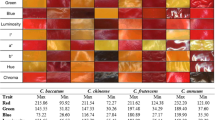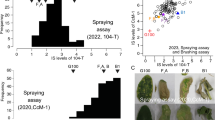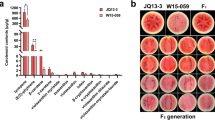Abstract
The fruit of commercial cranberry (Vaccinium macrocarpon Ait.) cultivars have relatively high concentrations of malic acid (MA) and citric acid (CA), and, to a lesser extent, quinic acid. These acids contribute to the high titratable acidity (TA), a measure of tartness, of cranberry fruit, which typically ranges from 2.3 to 2.5% citric acid equivalents in commercial cultivars. Thus, considerable amounts of sugar are added (“added sugar”) in products such as sweetened-dried cranberries and juices. Within our cranberry germplasm collection, a unique accession was identified with fruit having a TA ≈ 1.5%, where MA concentration was reduced to ~ 4 mg/g fresh weight (FW), compared to ~ 8 mg/g FW in current cultivars. Inbred crosses derived from this accession yielded progeny with a lower MA phenotype (~ 2 mg/g FW). Observed segregation indicated the accession was heterozygous (Mala/mala) for a low MA allele (mala) and very low MA progeny were homozygous (mala/mala). MA was reduced approximately 75% in these populations relative to standard cultivars. The homozygous mala/mala locus also depressed fruit CA and quinic acid concentrations. Quantitative trait loci mapping identified a region on chromosome 4 associated with low MA. The combined segregation of three half-sib populations derived from the low MA accession generated effective (within < 1 cM) Kompetitive allele-specific PCR (KASP) markers for use in breeding of cranberry cultivars with lower MA. Dihybrid populations were developed having a previously described low CA allele, cita, with the mala alleles of this study to explore the interaction of alleles at both loci.





Similar content being viewed by others
References
Bae H, Yun SK, Jun JH et al (2014) Assessment of organic acid and sugar composition in apricot, plumcot, plum, and peach during fruit development. J Appl Bot Food Qual 87:24–29. https://doi.org/10.5073/JABFQ.2014.087.004
Bai Y, Dougherty L, Li M et al (2012) A natural mutation-led truncation in one of the two aluminum-activated malate transporter-like genes at the Ma locus is associated with low fruit acidity in apple. Mol Gen Genomics 287:663–678. https://doi.org/10.1007/s00438-012-0707-7
Bates RP, Morris JR, Crandall PG (2001) Principles and practices of small- and medium- scale fruit juice processing. Food and Agriculture Organization, Rome, p 146
Boudehri K, Bendahmane A, Cardinet G et al (2009) Phenotypic and fine genetic characterization of the D locus controlling fruit acidity in peach. BMC Plant Biol 9:59. https://doi.org/10.1186/1471-2229-9-59
Broman KW, Wu H, Sen S, Churchill GA (2003) R/qtl: QTL mapping in experimental crosses. Bioinformatics 19:889–890. https://doi.org/10.1093/bioinformatics/btg112
Cantarel BL, Korf I, Robb SMC et al (2008) MAKER: An easy-to-use annotation pipeline designed for emerging model organism genomes. Genome Res 18:188–196. https://doi.org/10.1101/gr.6743907
Cao K, Zhou Z, Wang Q et al (2016) Genome-wide association study of 12 agronomic traits in peach. Nat Commun 7:13246. https://doi.org/10.1038/ncomms13246
Catchen JM, Amores A, Hohenlohe P et al (2011) Stacks: building and genotyping loci de novo from short-read sequences. G3: Genes. Genomes, Genetics 1:171–182. https://doi.org/10.1534/g3.111.000240
Cohen S, Tzuri G, Harel-Beja R et al (2012) Co-mapping studies of QTLs for fruit acidity and candidate genes of organic acid metabolism and proton transport in sweet melon (Cucumis melo L.). Theor Appl Genet 125:343–353. https://doi.org/10.1007/s00122-012-1837-3
Cornah JE, Germain V, Ward JL et al (2004) Lipid utilization, gluconeogenesis, and seedling growth in Arabidopsis mutants lacking the glycosylate cycle enzyme malate synthase. J Biol Chem 279:42916–42923. https://doi.org/10.1074/jbc.M407380200
Covarrubias-Pazaran G, Diaz-Garcia L, Schlautman B et al (2016) Exploiting genotyping by sequencing to characterize the genomic structure of the American cranberry through high-density linkage mapping. BMC Genomics 17:451. https://doi.org/10.1186/s12864-016-2802-3
Cunningham DG, Vannozzi SA, Turk R, Roderick R, O’Shea E, Brilliant K (2003) Cranberry phytochemicals and their health benefits. In: Nutraceutical Beverages, ACS Symposium Series. American Chemical Society, Washington DC, pp 35–51. https://doi.org/10.1021/bk-2004-0871.ch004
Daverdin G, Johnson-Cicalese J, Zalapa J et al (2017) Identification and mapping of fruit rot resistance QTL in American cranberry using GBS. Mol Breed 37:38. https://doi.org/10.1007/s11032-017-0639-3
Diaz-Garcia L, Schlautman B, Covarrubias-Pazaran G et al (2018) Massive phenotyping of multiple cranberry populations reveals novel QTLs for fruit anthocyanin content and other important chemical traits. Mol Gen Genomics 293:1379–1392. https://doi.org/10.1007/s00438-018-1464-z
Eduardo I, López-Girona E, Batlie I et al (2014) Development of diagnostic markers for selection of the subacid trait in peach. Tree Genet Genomes 10:1695–1709. https://doi.org/10.1007/s11295-014-0789-y
Etienne C, Moing A, Dirlewanger E et al (2002a) Isolation and characterization of six peach cDNAs encoding key proteins in organic acid metabolism and solute accumulation: involvement in regulating peach fruit acidity. Physiol Plant 114:259–270. https://doi.org/10.1034/j.1399-3054.2002.1140212.x
Etienne C, Rothan C, Moing A et al (2002b) Candidate genes and QTLs for sugar and organic acid content in peach [Prunus persica (L.) Batsch]. Theor Appl Genet 105:145–159. https://doi.org/10.1007/s00122-001-0841-9
Fong SK (2019) The genetics of organic acids variation in cranberry fruit. PhD Dissertation, Rutgers University
Fong SK, Kawash J, Wang Y et al (2020) A low citric acid trait in cranberry: genetics and molecular mapping of a locus impacting fruit acidity. Tree Genet Genomes 16:42. https://doi.org/10.1007/s11295-020-01432-4
Forney CF, Kalt W, Jordan MA et al (2012) Blueberry and cranberry fruit composition during development. J Berry Res 2:169–177. https://doi.org/10.3233/JBR-2012-034
Georgi L, Johnson-Cicalese J, Honig J et al (2013) The first genetic map of the American cranberry: exploration of synteny conservation and quantitative trait loci. Theor Appl Genet 126:673–692. https://doi.org/10.1007/s00122-012-2010-8
Hála M, Cole R, Synek L et al (2008) An exocyst complex functions in plant cell growth in Arabidopsis and tobacco. Plant Cell 20:1330–1345. https://doi.org/10.1105/tpc.108.059105
Kader AA (2008) Flavor quality of fruits and vegetables. J Sci Food Agric 88:1863–1868. https://doi.org/10.1002/jsfa.3293
Kallio H, Hakala M, Pelkkikangas A-M, Lapveteläinen A (2000) Sugars and acids of strawberry varieties. Eur Food Res Technol 212:81–85. https://doi.org/10.1007/s002170000244
Lambert P, Campoy JA, Pacheco I et al (2016) Identifying SNP markers tightly associated with six major genes in peach [Prunus persica (L.) Batsch] using a high-density SNP array with an objective of marker-assisted selection (MAS). Tree Genet Genomes 12:121. https://doi.org/10.1007/s11295-016-1080-1
Li H (2011) A statistical framework for SNP calling, mutation discovery, association mapping and population genetical parameter estimation from sequencing data. Bioinformatics 27:2987–2993. https://doi.org/10.1093/bioinformatics/btr509
Li H, Durbin R (2009) Fast and accurate short read alignment with Burrows–Wheeler transform. Bioinformatics 25:1754–1760. https://doi.org/10.1093/bioinformatics/btp324
Lobit P, Soing P, Génard M, Habib R (2002) Theoretical analysis of relationships between composition, pH, and titratable acidity of peach fruit. J Plant Nutr 25:2775–2792. https://doi.org/10.1081/PLN-120015538
Marsh KB, Boldingh HL, Shilton RS, Laing WA (2009) Changes in quinic acid metabolism during fruit development in three kiwifruit species. Funct Plant Biol 36:463–470. https://doi.org/10.1071/FP08240
McCamey DA, Thrope TM, McCarthy JP (1990) Coffee bitterness. In: Rouseff RL (ed) Bitterness in foods and beverages. Elsevier Science Publishers B.V, Amsterdam, The Netherlands, pp 169–182
Moing A, Svanella L, Rolin D et al (1998) Compositional changes during the fruit development of two peach cultivars differing in juice acidity. J Am Soc Hortic Sci 123:770–775. https://doi.org/10.21273/JASHS.123.5.770
Nishiyama I, Fukuda T, Shimohashi A, Oota T (2008) Sugar and organic acid composition in the fruit juice of different Actinidia varieties. Food Sci Technol Res 14:67–73. https://doi.org/10.3136/fstr.14.67
Nováková P, Hirsch S, Feraru E et al (2014) SAC phosphoinositide phosphatases at the tonoplast mediate vacuolar function in Arabidopsis. Proc Natl Acad Sci USA 111:2818–2823. https://doi.org/10.1073/pnas.1324264111
Original Dried Cranberries (2019) Ocean Spray®. https://www.oceanspray.com:443/sitecore/content/OS/Brand Sites/OceanSpray/Master/Intl Master/Data/Products/Craisins Dried Cranberries/Craisins Original Dried Cranberries. Accessed 10 Mar 2019
Polashock J, Zelzion E, Fajardo D et al (2014) The American cranberry: first insights into the whole genome of a species adapted to bog habitat. BMC Plant Biol 14:165. https://doi.org/10.1186/1471-2229-14-165
Rosas JE, Bonnecarrère V, Pérez de Vida F (2014) One-step, codominant detection of imidazolinone resistance mutations in weedy rice (Oryza sativa L.). Electron J Biotechnol 17:95–101. https://doi.org/10.1016/j.ejbt.2014.02.003
Rubico SM, McDaniel MR (1992) Sensory evaluation of acids by free-choice profiling. Chem Senses 17:273–289. https://doi.org/10.1093/chemse/17.3.273
Schlautman B, Covarrubias-Pazaran G, Diaz-Garcia LA et al (2015) Development of a high-density cranberry SSR linkage map for comparative genetic analysis and trait detection. Mol Breed 35:177. https://doi.org/10.1007/s11032-015-0367-5
Schlautman B, Covarrubias-Pazaran G, Diaz-Garcia L et al (2017) Construction of a high-density American cranberry (Vaccinium macrocarpon ait.) composite map using genotyping-by-sequencing for multi-pedigree linkage mapping. G3 (Bethesda) 7:1177–1189. https://doi.org/10.1534/g3.116.037556
Vorsa N, Johnson-Cicalese J (2012) American cranberry. In: Badenes ML, Byrne DH (eds) Fruit Breeding. Springer US, Boston, MA, pp 191–223
Wang Y, Johnson-Cicalese J, Singh AP, Vorsa N (2017) Characterization and quantification of flavonoids and organic acids over fruit development in American cranberry (Vaccinium macrocarpon) cultivars using HPLC and APCI-MS/MS. Plant Sci 262:91–102. https://doi.org/10.1016/j.plantsci.2017.06.004
Wang Y, Fong SK, Singh AP et al (2019) Variation of anthocyanins, proanthocyanidins, flavonols, and organic acids in cultivated and wild diploid blueberry species. HortScience 54:576–585. https://doi.org/10.21273/HORTSCI13491-18
Xiong L, Gong Z, Rock CD et al (2001) Modulation of abscisic acid signal transduction and biosynthesis by an sm-like protein in Arabidopsis. Dev Cell 1:771–781. https://doi.org/10.1016/S1534-5807(01)00087-9
Xu K, Wang A, Brown S (2012) Genetic characterization of the Ma locus with pH and titratable acidity in apple. Mol Breed 30:899–912. https://doi.org/10.1007/s11032-011-9674-7
Ye J, Wang X, Hu T et al (2017) An InDel in the promoter of Al-ACTIVATED MALATE TRANSPORTER9 selected during tomato domestication determines fruit malate contents and aluminum tolerance. Plant Cell 29:2249–2268. https://doi.org/10.1105/tpc.17.00211
Zeballos JL, Abidi W, Giménez R et al (2016) Mapping QTLs associated with fruit quality traits in peach [Prunus persica (L.) Batsch] using SNP maps. Tree Genet Genomes 12:37. https://doi.org/10.1007/s11295-016-0996-9
Zhang Y, Li P, Cheng L (2010) Developmental changes of carbohydrates, organic acids, amino acids, and phenolic compounds in ‘Honeycrisp’ apple flesh. Food Chem 123:1013–1018. https://doi.org/10.1016/j.foodchem.2010.05.053
Funding
This research was funded through the following agencies and groups: USDA-NIFA-AFRI Grant 2017-67013-26215, New Jersey Blueberry and Cranberry Research Council, Cranberry Institute.
Author information
Authors and Affiliations
Corresponding author
Additional information
Communicated by C. Chen
Publisher’s note
Springer Nature remains neutral with regard to jurisdictional claims in published maps and institutional affiliations.
Supplementary Information
ESM 1
(DOCX 363 kb)
Rights and permissions
About this article
Cite this article
Fong, S.K., Kawash, J., Wang, Y. et al. A low malic acid trait in cranberry fruit: genetics, molecular mapping, and interaction with a citric acid locus. Tree Genetics & Genomes 17, 4 (2021). https://doi.org/10.1007/s11295-020-01482-8
Received:
Revised:
Accepted:
Published:
DOI: https://doi.org/10.1007/s11295-020-01482-8




